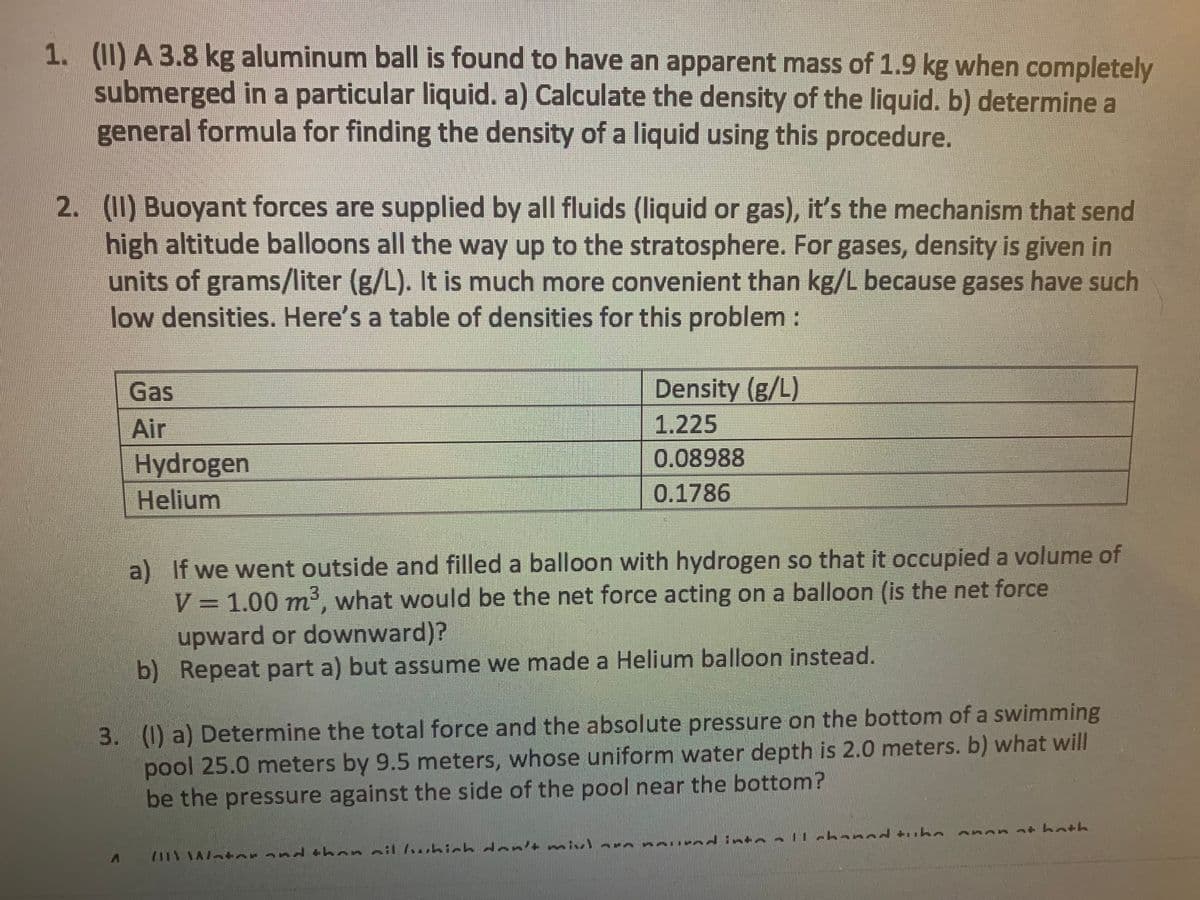2. (I1) Buoyant forces are supplied by all fluids (liquid or gas), it's the mechanism that send high altitude balloons all the way up to the stratosphere. For gases, density is given in units of grams/liter (g/L). It is much more convenient than kg/L because gases have such low densities. Here's a table of densities for this problem : Gas Density (g/L) Air 1.225 0.08988 Hydrogen Helium 0.1786 a) If we went outside and filled a balloon with hydrogen so that it occupied a volume of V = 1.00 m3, what would be the net force acting on a balloon (is the net force upward or downward)? b) Repeat part a) but assume we made a Helium balloon instead.
2. (I1) Buoyant forces are supplied by all fluids (liquid or gas), it's the mechanism that send high altitude balloons all the way up to the stratosphere. For gases, density is given in units of grams/liter (g/L). It is much more convenient than kg/L because gases have such low densities. Here's a table of densities for this problem : Gas Density (g/L) Air 1.225 0.08988 Hydrogen Helium 0.1786 a) If we went outside and filled a balloon with hydrogen so that it occupied a volume of V = 1.00 m3, what would be the net force acting on a balloon (is the net force upward or downward)? b) Repeat part a) but assume we made a Helium balloon instead.
Physics for Scientists and Engineers: Foundations and Connections
1st Edition
ISBN:9781133939146
Author:Katz, Debora M.
Publisher:Katz, Debora M.
Chapter15: Fluids
Section15.4: Archimedes’s Principle
Problem 15.5CE
Related questions
Question
100%
please answer question 2, a and b.

Transcribed Image Text:1. (II) A 3.8 kg aluminum ball is found to have an apparent mass of 1.9 kg when completely
submerged in a particular liquid. a) Calculate the density of the liquid. b) determine a
general formula for finding the density of a liquid using this procedure.
2. (I1) Buoyant forces are supplied by all fluids (liquid or gas), it's the mechanism that send
high altitude balloons all the way up to the stratosphere. For gases, density is given in
units of grams/liter (g/L). It is much more convenient than kg/L because gases have such
low densities. Here's a table of densities for this problem:
Gas
Density (g/L)
Air
1.225
0.08988
Hydrogen
Helium
0.1786
a) If we went outside and filled a balloon with hydrogen so that it occupied a volume of
V 1.00 m, what would be the net force acting on a balloon (is the net force
upward or downward)?
b) Repeat part a) but assume we made a Helium balloon instead.
3. (I) a) Determine the total force and the absolute pressure on the bottom of a swimming
pool 25.0 meters by 9.5 meters, whose uniform water depth is 2.0 meters. b) what will
be the pressure against the side of the pool near the bottom?
nt hath
il 1...hich dan
7111 AA/ ter and +hon ail wbich den'+mix)arn neu ed into llchanad tuhe
Expert Solution
This question has been solved!
Explore an expertly crafted, step-by-step solution for a thorough understanding of key concepts.
Step by step
Solved in 2 steps with 1 images

Knowledge Booster
Learn more about
Need a deep-dive on the concept behind this application? Look no further. Learn more about this topic, physics and related others by exploring similar questions and additional content below.Recommended textbooks for you

Physics for Scientists and Engineers: Foundations…
Physics
ISBN:
9781133939146
Author:
Katz, Debora M.
Publisher:
Cengage Learning

College Physics
Physics
ISBN:
9781305952300
Author:
Raymond A. Serway, Chris Vuille
Publisher:
Cengage Learning

College Physics
Physics
ISBN:
9781938168000
Author:
Paul Peter Urone, Roger Hinrichs
Publisher:
OpenStax College

Physics for Scientists and Engineers: Foundations…
Physics
ISBN:
9781133939146
Author:
Katz, Debora M.
Publisher:
Cengage Learning

College Physics
Physics
ISBN:
9781305952300
Author:
Raymond A. Serway, Chris Vuille
Publisher:
Cengage Learning

College Physics
Physics
ISBN:
9781938168000
Author:
Paul Peter Urone, Roger Hinrichs
Publisher:
OpenStax College

University Physics Volume 1
Physics
ISBN:
9781938168277
Author:
William Moebs, Samuel J. Ling, Jeff Sanny
Publisher:
OpenStax - Rice University

College Physics
Physics
ISBN:
9781285737027
Author:
Raymond A. Serway, Chris Vuille
Publisher:
Cengage Learning

Physics for Scientists and Engineers, Technology …
Physics
ISBN:
9781305116399
Author:
Raymond A. Serway, John W. Jewett
Publisher:
Cengage Learning